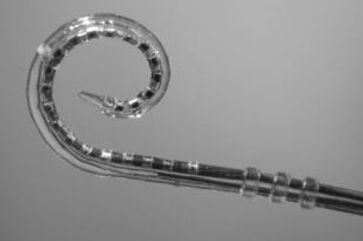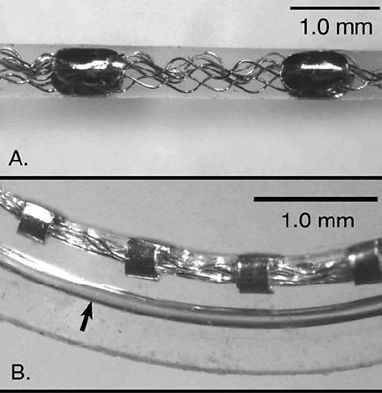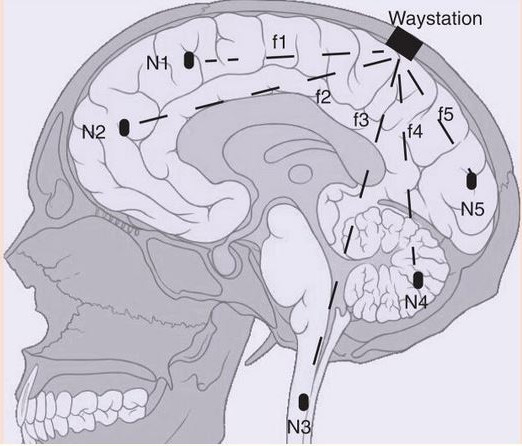
Microchip Technology
William Pawelec helped invent microchips and the technology was stolen and used for something other than what had been intended.
Mr. William Pawelec was a U.S. Air Force computer operations and programming specialist with numerous credentials in security technologies and access control systems. He gave this interview with Dr. Greer prior to the 2001 National Press Club Disclosure event and asked that it not be released until after his death. We recently found out that Mr. William Pawelec passed away on May 22, 2007 and we received permission to release it in December 2010.
‘The Powers That Be’ stole the technology. Two of those friends were assassinated and Bill’s own death remains suspicious.” An RFID chip is a tiny radio-frequency identification chip that is small enough to inject into animals and humans for monitoring purposes.
Pawelec shaken to core at secret meeting “Another project Bill worked on was at Area 51,” Annie continues. “It was his job to upgrade the perimeter security systems for Area 51 and it was his idea to install cameras in fake rocks. It was during this time that he learned about the Tonapah base which is more remote and inaccessible than Area 51. It also was where Bill’s rose-colored patriotic glasses began to cloud over.
William Pawelec
Cochlear Implants:System Design, Integration and Evaluation
Fan-Gang Zeng, (fzeng@uci.edu) et al.
January 1, 2008
Abstract
As the most successful neural prosthesis, cochlear implants have provided partial hearing to more than 120,000 persons worldwide; half of which being pediatric users who are able to develop nearly normal language. Biomedical engineers have played a central role in the design, integration and evaluation of the cochlear implant system, but the overall success is a result of collaborative work with physiologists, psychologists, physicians, educators, and entrepreneurs. This review presents broad yet in-depth academic and industrial perspectives on the underlying research and ongoing development of cochlear implants. The introduction accounts for major events and advances in cochlear implants, including dynamic interplays among engineers, scientists, physicians, and policymakers. The review takes a system approach to address critical issues from design and specifications to integration and evaluation. First, the cochlear implant system design and specifications are laid out. Second, the design goals, principles, and methods of the subsystem components are identified from the external speech processor and radio frequency transmission link to the internal receiver, stimulator and electrode arrays. Third, system integration and functional evaluation are presented with respect to safety, reliability, and challenges facing the present and future cochlear implant designers and users. Finally, issues beyond cochlear implants are discussed to address treatment options for the entire spectrum of hearing impairment as well as to use the cochlear implant as a model to design and evaluate other similar neural prostheses such as vestibular and retinal implants.
Hearing Restoration with Auditory Brainstem Implant
Hirofumi NAKATOMI, et al. July 26, 2016
Abstract
Auditory brainstem implant (ABI) technology attempts to restore hearing in deaf patients caused by bilateral cochlear nerve injury through the direct stimulation of the brainstem, but many aspects of the related mechanisms remain unknown. The unresolved issues can be grouped into three topics: which patients are the best candidates; which type of electrode should be used; and how to improve restored hearing. We evaluated our experience with 11 cases of ABI placement. We found that if at least seven of eleven electrodes of the MED-EL ABI are effectively placed in a patient with no deformation of the fourth ventricle, open set sentence recognition of approximately 20% and closed set word recognition of approximately 65% can be achieved only with the ABI. Appropriate selection of patients for ABI placement can lead to good outcomes. Further investigation is required regarding patient selection criteria and methods of surgery for effective ABI placement.
Wireless communication with implanted medical devices using the conductive properties of the body
John E Ferguson, A David Redish, July, 2011
Abstract
Many medical devices that are implanted in the body use wires or wireless radiofrequency telemetry to communicate with circuitry outside the body. However, the wires are a common source of surgical complications, including breakage, infection and electrical noise. In addition, radiofrequency telemetry requires large amounts of power and results in low-efficiency transmission through biological tissue. As an alternative, the conductive properties of the body can be used to enable wireless communication with implanted devices. In this article, several methods of intrabody communication are described and compared. In addition to reducing the complications that occur with current implantable medical devices, intrabody communication can enable novel types of miniature devices for research and clinical applications.
Wireless Communication in the Body
Vqrious methods are used to implant these devices.
"For a miniature implantable device, alternative approaches to positioning the implant within the body are necessary. The easiest way to insert an implant is by injecting it with a hypodermic needle. This technique is commonly used for implanting RFID tags into the bodies of livestock for identification [29]. For implantation in the brain, the hard needle protects the implant from the forces encountered when penetrating through dura and brain tissue. However, the volume of brain tissue displaced is larger than if the implant were moved alone. In addition, the positive pressure from the syringe may cause damage to tissue.An alternative to a hypodermic needle is to use a vacuum-based tool, similar to the vacuum pickup tools used in placing microelectronic components. In this setup, the implant is held tothe tip of a hollow tube by vacuum. Once inserted to the desired depth, the vacuum is released and the tool is retracted, leaving the implant in place.Another approach to inserting implants is using magnetic guidance, originally developed to guide catheters within the brain [30] and for drug delivery of nanoparticles [31]. In magnetic guidance, several large external superconducting magnets control the movement of permanent magnets integrated in the implant. This system allows for control in three dimensions and for easy repositioning of the implant. Nonlinear trajectories can even beused to avoid sensitive regions of the brain, which would be impossible in a traditional linear stereotactic approach. However, the implant must be magnetically sensitive, and a complex purpose-built system is required to control the magnetic implant. Another potential concern is unintentional movement of the magnetic implant after implantation due to magnetic forces in the environment or from MRI.Dissolvable silk films, which have recently been used to create a mesh for electrodes placed conformably on the brain surface [32], could also potentially be used in implanting miniature wireless devices. Silk films dissolve over time, leaving the implant completely unconnected to any wires or fibers. The silk structure attached to the implant can also be used to move or extract the implant during the first few days or weeks before the fibers dissolve."
The Senses of Sensors
Sensors used in industrial and tech environments have been adapted for implantation in the human body to simulate sight, sound, touch, smell and vision.
the “Five Senses of Sensors” articles published in TechZone in 2011 (Sound, Vision, Taste, Smell, and Touch), we will discuss advances in sensor technology that mimic and mirror human smell, taste, and hearing. The article will focus on changes in the underlying sensors and how applications have grown, particularly in light of the emergence of the Internet of Things (IoT).
MIT engineers configure RFID tags to work as sensors
Platform may enable continuous, low-cost, reliable devices that detect chemicals in the environment.
Jennifer Chu | MIT News Office
June 14, 2018
The Auto-ID Lab at MIT has long been at the forefront of developing RFID technology. Now engineers in this group are flipping the technology toward a new function: sensing. They have developed a new ultra-high-frequency, or UHF, RFID tag-sensor configuration that senses spikes in glucose and wirelessly transmits this information. In the future, the team plans to tailor the tag to sense chemicals and gases in the environment, such as carbon monoxide.
There are many classes of e-noses, including those with conductive polymer, surface acoustic wave, calorimetric, and polymer composite. Often there are several types or classes of sensors used in these applications, including optical-sensor systems, mass and ion mobility spectrometry, gas chromatography, infrared spectrometry, and chemical sensors. An example of a gas sensor used for CO2 detection is Amphenol’s Telaire 6613 CO2 Module (Figure 1). The small, compact module is designed to integrate into existing controls and equipment to meet the volume, cost, and delivery expectations of OEMs.

Sensors that detect sound or “hear” are essentially microphones with sophisticated signal-processing capability. In robotics, sound sensors are used in a myriad of applications. One sensor particularly well-suited for sound-based application is the Parallax Sound Impact Sensor (manufacturer’s part number 29132, Figure 2) that provides noise control to a project and responds to loud noises such as a clap of the hands.
Through the on-board microphone, this sensor detects changes in decibel level, which triggers a high pulse to be sent through the signal pin of the sensor. This change can be read by an I/O pin of any Parallax microcontroller. Detection range up to 3 meters away and an on-board potentiometer provides an adjustable range of detection.

The Microchip MTCH6301 capacitive touch controller (Figure 1). The MTCH6301 is a turnkey-projected capacitive controller. Through a sophisticated combination of self- and mutual-capacitive scanning for both XY screens and touch pads, the MTCH6301 allows designers to quickly and easily integrate projected capacitive touch into such applications as:
-
Human-machine interfaces (HMIs) with configurable button, keypad, or scrolling functions
-
Single-finger gesture-based interfaces to swipe, scroll, or double tap controls
-
Home automation and security control panels
-
Automotive center stack controls

The Silicon Labs Si1145/46/47 (Figure 2) is a low-power, reflectance-based, infrared-proximity, ultraviolet (UV) index, and ambient-light sensor with I2C digital interface and programmable event-interrupt output. This touchless sensor IC features an analog-to-digital converter, integrated, high-sensitivity visible and infrared photodiodes, a digital-signal processor, and one, two, or three integrated infrared LED drivers with fifteen selectable drive levels. The Si1145/46/47 offers excellent performance under a wide dynamic range and a variety of light sources from direct sunlight to dark glass covers. Using two or more LEDs, the device is capable of supporting multiple-axis proximity motion detection. Applications include handsets, e-book readers, notebooks and netbooks, portable consumer electronics, audio products, tamper-detection ICs and security panels, industrial automation, and more.
Silicon Labs introduced a Zero Gecko Starter Kit with sensor expansion board (Figure 3) that is fully supported with Simplicity Studio, which features precompiled demos, application notes, and examples. The kit includes the Si1147 proximity sensor, as well as an Si7013 humidity and temperature sensor, an EFM32ZG-STK3200 Zero Gecko, and all IR LEDs and optomechanical components necessary for development of gesture and proximity applications.
Ultrasonic sensors are used to detect the existence of objects (digital) and distance (analog) in factory automation and processing. Sound is better for this application than light because sound is not affected by reflectivity, translucence, or color.
The Honeywell 94X Series Ultrasonic Distance Sensors, for example, offer enhanced sensing range capability. The non-contact distance sensing is used for non-invasive measurement. Its reduced sensitivity to light intensity, reflectivity, and opacity of a target offers flexibility and greater accuracy. With a sensing distance of up to 19.65 feet, it detects over a longer distance than other method so there is no need for close proximity to a target. Applications include level measurement, presence/absence detection, and measurement of distance.
Ultrasonic rangefinders are commonly used as collision detectors so they are placed low, but not low enough to reflect off the ground with a wide beam. It can also be angled down and placed higher to avoid the reflection dilemma.
Parallax's PING)))™ ultrasonic sensor provides a very low-cost and easy method of distance measurement. This sensor is ideal for any number of applications that require measurements be performed between moving or stationary objects. Naturally, robotics applications are very popular but this product also is useful in security systems or as an infrared replacement. The sensor includes an activity status LED and uses just one I/O pin.
There are a many chemical gas sensors, systems, and modules available to assist with development. One such module is a gas sensor module series by Parallax capable of measuring methane, carbon monoxide, propane, and alcohol. In the case of this series, a 4-pin SIP header on the Gas Sensor Module makes it easy to connect to a breadboard or SIP socket. Connection to a 5-V microcontroller is straightforward, requiring two I/O pins. For a 3.3-V MCU, an additional resistor and npn switching transistor would be required. See schematic
















